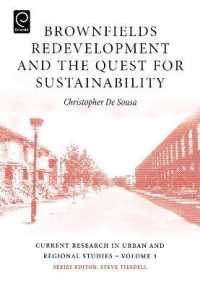- ホーム
- > 洋書
- > 英文書
- > Science / Mathematics
Full Description
Well-illustrated introduction to building pathology, bridging the gap between building surveying and the detailed understanding of building defects, their prognosis and remediation
Building Pathology introduces the concept of building pathology and aims to give the reader a greater awareness and understanding of buildings and their users, to assist in defect diagnosis and the design and implementation of specific and appropriate remedial measures. By focusing on the process, rather than specific solutions, the book helps the reader to use the information in their practice in a wide variety of situations.
The new third edition features new case studies which have been integrated into the text. Written by a highly qualified author with significant experience in the field, the third edition of Building Pathology contains information on:
Building performance, covering environmental factors, user requirements, building structures and materials
Defects, damage, and decay, covering atmospheric and climatic action, excess moisture, chemical, physical, and biological action, movement, fire and human factors
Survey and assessment, covering building inspections and surveys, how to prioritize defects, unoccupied buildings and sites, and redundant and ruined buildings
Remediation in practice, covering real-world examples
With comprehensive coverage of the subject, Building Pathology is an essential learning resource for students of building surveying, as well as professional architects, building surveyors, property managers and those working in heritage disciplines.
Contents
About the Author xi
Preface to Third Edition xiii
1 Introduction 1
What is building pathology? 1
Why take a holistic approach to understanding buildings? 2
The relevance of building pathology 6
The principles and practice of building pathology 7
References 7
2 Understanding Buildings 9
What is a building? 9
Perceptions of buildings 13
Classification of buildings 16
Requirements of buildings 17
Our expectations of buildings 23
The way forward 27
Reference 28
Further reading 28
3 Building Performance 29
Why do buildings stand up? 29
Building structures 31
Building materials 36
Understanding building materials 37
Sources of building materials 39
Timber 42
Plant material 47
Stone 48
Ceramics 54
Binders and concrete 58
Metals 65
Glass 71
Bituminous products 73
Modern materials 74
Unusual materials 77
Building services 77
The building as a whole 82
Understanding buildings and building performance 83
Assessing building performance 83
How the construction industry needs to change 85
References 86
Further reading 87
4 Defects, Damage and Decay 89
What is a building defect? 89
Nature of building defects 90
Causes and effects of defects, damage and decay 95
Atmospheric and climatic action 98
Excess moisture 108
Chemical, physical and biological action 116
Movement 135
Fire 137
Human factors 139
References 142
Further reading 142
5 Survey and Assessment 145
Fault-finding 145
Building inspections and surveys 146
Assessment of defects 154
Severity of defects 155
Prioritising defects and remedial works 157
Unoccupied buildings and sites 158
Redundant and ruined buildings 159
Diagnosis and prognosis of defects 162
Non-destructive investigations 169
Monitoring defects 175
Environmental conditions 179
References 180
Further reading 180
6 Principles into Practice 183
Putting principles into practice 183
The changing fortunes of buildings 183
Looking forward by looking backwards 187
Cross-laminated timber buildings and their common defects 191
Understanding buildings: St Fagans National Museum of History 202
Relationship between fire and building pathology 208
Carrying out inspections and working at height 224
Conservation management plan for Marx Memorial Library 230
Training surveyors using script concordance testing 239
Scientific investigations at Hill House 243
Monitoring seismic movement at a church in Corfu 248
Diagnosing defects in a Martello tower 251
Using simple measurements to understand a problem 255
Bats in churches 258
Lincoln Cathedral's west front and Romanesque frieze 262
Planned preventative maintenance for Britten Pears Arts 270
Retrofit for rural National Trust buildings 279
New Court - a retrofit workflow by ArchiMetrics Ltd 285
Buildings on paper and in practice 292
Heritage, health and well-being 302
Dealing with chemical contamination in a building 306
Sustainable housing for the future 315
Lessons to be learned 319
7 Building Management and Aftercare 321
Planning the future 321
What can be done with buildings? 321
Managing building and change 324
Limitations of existing buildings 325
Finding the right use for a building 327
Making use of historic buildings and sites 328
Principles of conservation and building repairs 331
Principles of building maintenance 335
Planned preventive maintenance 337
Principles of retrofit 338
Climate resilience and mitigation 339
Planning for disasters and emergencies 341
Managing unoccupied buildings and sites 343
Heritage crime 346
Health and the built environment 347
Issues of sustainability and sustainable development 355
Stewardship and assessments of value 357
Buildings for the present and the future 359
References 360
Further reading 360
Appendix A Requirements of Approved Documents Supporting Schedule 1 to Building Regulations 2010 365
Appendix B Hazard Identification Checklist 381
Appendix C Useful Contacts 389
Appendix D Warning Bells 395
Glossary 399
Index 405








